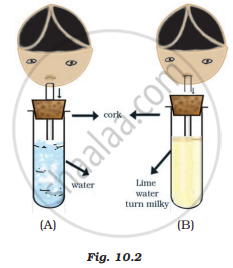Advertisements
Advertisements
Question
Differentiate between
External respiration and Internal respiration
Solution
| External respiration | Internal respiration | ||
| 1 | It is the mechanical process of inhaling and exhaling air It does not involve any enzymes. | 1 | It is a complex biochemical process in which ensure involved. |
| 2 | It is the mechanical process of inhaling and exhaling air It does not involve any enzymes. | 2 | It involves the oxidation of glucose into carbon dioxide, water, and energy. |
| 3 | No energy is released. | 3 | Energy is released and stored in the form of ATP. |
| 4 | It takes place outside the cell. | 4 | It takes place inside the cell. |
APPEARS IN
RELATED QUESTIONS
Mention any two components of blood.
What is the name of tiny air-sacs at the end of smallest bronchioles in the lungs?
Fill in the following blank with suitable word:
Gills are the breathing organs in ___________.
Describe the process of respiration in the following part of a plant:
Stem
How are oxygen and carbon dioxide exchanged in our body during respiration?
Which of the following is most likely to have a much higher breathing rate?
Answer the following in one word.
What is the muscular sheet below the lungs called?
Name the body structure concerned with the given functional activity:
Prevents food from entering the trachea during swallowing.
The Figure shown below represents an activity to prove the requirements for photosynthesis. During this activity, two healthy potted plants were kept in the dark for 72 hours. After 72 hours, KOH is kept in the watch glass in setup X and not in setup Y. Both these setups are air tight and have been kept in light for 6 hours. Then, Iodine Test is performed with one leaf from each of the two plants X and Y.

The function of KOH is to absorb ______.
Observe Figure 10.2 carefully and answer the following questions.

- Which process is being tested in the activity?
- What is the result of the activity? Give reasons.
